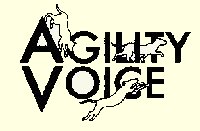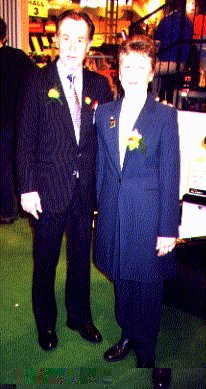| |
A word to the wise...
 This wonderful
editorial, written by John Gilbert, comes from the Agility Voice archives
from the days
when the dogwalk was known as the cat-walk. Have things changed in 25 years? Read on and judge
for yourself. This wonderful
editorial, written by John Gilbert, comes from the Agility Voice archives
from the days
when the dogwalk was known as the cat-walk. Have things changed in 25 years? Read on and judge
for yourself.
Because Agility is still a fairly new sport compared with Obedience or
Working Trials, the amount of judges available with the right credentials is limited to a small
number. However, although the number may be small the quality, I feel, at the moment is very
high, and we should continue to strive to make sure that the high standard of Agility judges
remains as high as possible.
Whilst it is not always the case that the top handlers make the best judges,
it would be difficult to argue against their experience, and if there is one single quality an
Agility judge must have, it's experience.
 While choosing a judge, societies must remember that it is not only the
marking of faults but the design of the course which is most important. To be able to plan a
safe, interesting course, with subtle changes of speed and handling ability, and then allow the
correct time for it requires a great deal of expertise that can only be gained by handling a
dog in competitive agility. While choosing a judge, societies must remember that it is not only the
marking of faults but the design of the course which is most important. To be able to plan a
safe, interesting course, with subtle changes of speed and handling ability, and then allow the
correct time for it requires a great deal of expertise that can only be gained by handling a
dog in competitive agility.
Safety First
To ensure the dog's safety much thought should be given to the position of such
obstacles as the scale, catwalk, see-saw, spread jump and tyre. Also the distance between
hurdles is another factor which requires much thought.
The tyre is, in my opinion, an obstacle which if positioned in a fast section
should always be straight on to the dog to allow a clean jump through. If it is placed at even
a slight angle, the aperture size is decreased considerably, therefore increasing the risk of a
dog twisting on the way through, or perhaps even worse, hitting the framework on the landing
side.
Much the same care should be taken when positioning the contact point
obstacles. They can, of course, be placed at an angle or on a corner, but thought should be
given to the obstacle that precedes them in the course to give the dog and handler a chance to
'straighten up' before attempting it. We must not forget that the whole idea of contact points
is to try and ensure the dog's safety on take-off and more important, on landing. They are not
there just to catch the dog out.
Hurdles, if made correctly (i.e. able to be knocked down from either side),
are perfectly safe providing some thought is given to the distance between them if placed on a
fast stretch. From experience, five years between seems right, for if they are put too close a
dog that jumps 'long' puts considerable strain on his spine when adjusting himself for the next
jump. This article is not intended to make courses easier - just to promote some thought in
their design.
Good Sportsmanship
As the sport gets bigger and the competition gets even keener, and a great number of newcomers
enter into it, we all have a duty to ensure that another quality remains as high as possible,
specifically regarding the competitors' standard of behaviour, in particular towards the judge.
A judge is engaged by a society to give opinions based on knowledge,
experience and fair-mindedness on the dogs entered under him/her and deserves respect from all
competitors - winners and losers. In the event of a query (we have all done what we thought was
a clear round only to be docked 5 faults) a polite approach to the judge will get you an
explanation - it may not be the answer you want but it will be the judge's opinion, and that is
what he/she is there for.
In a couple of instances lately competitors have shouted across the ring to
the judge with remarks like 'My dog never missed that ~@!"contact point,' or 'That was never a
refusal.' In another incident a competitor complained that he 'hadn't driven 120 miles to be
given five faults by you.' This incidentally was a judge with the highest credentials, both in
Obedience and Agility, and well known for setting super courses.
This sort of rude, bully behaviour must not be allowed to continue by all of
us who love agility, otherwise the net result will be that our best judges will give up to make
way for weaker, less experienced people who, in an effort to climb the judging ladder, will
give in to these sort of tactics and whole structure of agility, so carefully nurtured over the
last six years by a few people with vast experience and a great feeling for the sport, will
crumble into a meaningless circus.
So come on competitors - sportsmanship is not a dirty word.
Reprinted with kind permission of John Gilbert from the August 1984 edition of the
Agility Voice Newsletter.
Many thanks to Bill McLaughlin for lending
Agilitynet his wonderful collection of Agility
Voices.
| |
|